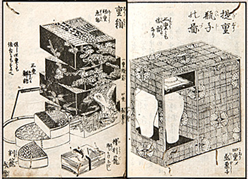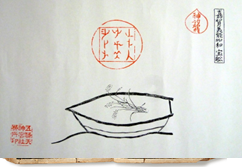Rice Harvesting Season/Land of Rice Japan “Itadakimasu” and “Thank you for the meal
Yoshie Doi
 |
 |
“Cooking Instruction Book” presentation
 “Kagami no Kawa Treasure Ship” Gojo Tenmangu Shrine Japan’s oldest treasure ship has its roots in a simple boat with a bundle of rice |
 Characters from the Age of Gods |
 Crystal of Water “Message from Water” Masaru Emoto Crystal of Water “Message from Water” Masaru Emoto |
Autumn is the season for rice harvesting. It’s a fun time to pass by rice fields on my way to work. It has a unique smell. Japan is a country of rice, and the Japanese people used to call grains of rice bodhisattvas and gods, and taught them not to waste them. I was taught as a child that each grain is precious.
In the olden days, Japanese people were taught that a grain of rice was called Bodhisattva and should not be wasted.
Ever since I was a child, there was a time when I loved bread so much that I decided that I would become a baker in the future. When I didn’t eat a grain of rice for a year, my mother severely scolded me and called an “unpatriot.” “How dare you eat flour when we has a surplus of old rice,” I recalls being told. I am now a rice eater and eats brown rice. I also make miso soup in the morning and eat mostly Japanese food.
The word “wa” in Japanese cuisine refers to the people who eat rice in their mouths, and whose staple food is grain and rice. Rice is connected to the root of life, and it has been said that there is no other treasure than rice, as it is the root that connects human life.
The rice treasure boat that has been passed down at Gojo Tenmangu Shrine is a simple one with a bunch of rice, but it is also the root of Japan’s treasure boat. Sukunahikona-no-Mikoto, the enshrined deity of Gojo Tenjingu Shrine, rode on the mountain when he descended from Takamagahara to the land of Izumo at the command of the divine king. It is said that the ears of rice on the ship turned into the Seven Lucky Gods.
According to the historical abbreviation of the treasure ship map at Gojo Tenjingu Shrine, the red stamp on the top right of the map reads “Jinnyokaji,” and the round red seal in the center is a nine-letter word from the mythological period that reads “Teiyokuheri Homii,” and although the meaning is unknown, it is a prayer. It has been with. The characters from this mythical era were from the age of the gods, when the emperor ruled, and are said to have become the basis for later hiragana characters, but they stopped being used after kanji came into use during the era of Prince Shotoku.
Nowadays, only experts can decipher these ancient scripts, but these days I often feel the wonders of the Japanese language.
“Itadakimasu” and “Thank you for the meal” are words unique to Japanese that cannot be translated into English. “Itadakimasu” expresses gratitude, “I’ll take your life as mine.” “Thank you for the meal” is said at the end of a meal to express gratitude to the people who ran around securing the ingredients, those who cooked the ingredients, and those who grew the ingredients.
Nowadays, the logistics system has advanced and you can buy anything at convenience stores, department stores, and supermarkets, but if you eat with this feeling of gratitude, you will absorb more nutrients.
Masaru Emoto, who studied water, wrote in “Message from Water” that negative emotions prevent water from crystallizing, while positive emotions cause water to develop into a beautiful hexagonal shape.
When it was published in 1999, a friend of his bought the book and told me about it. The emotion I felt at that time continues even today.
70% of the human body is made up of water. That’s why I always say “Thank you” to myself. In other words, if you deny yourself that you are an idiot, you will destroy yourself. “Itadakimasu” and “Gochisousama deshita” are expressions unique to Japan, and they have great philosophical meaning.
The end of document
